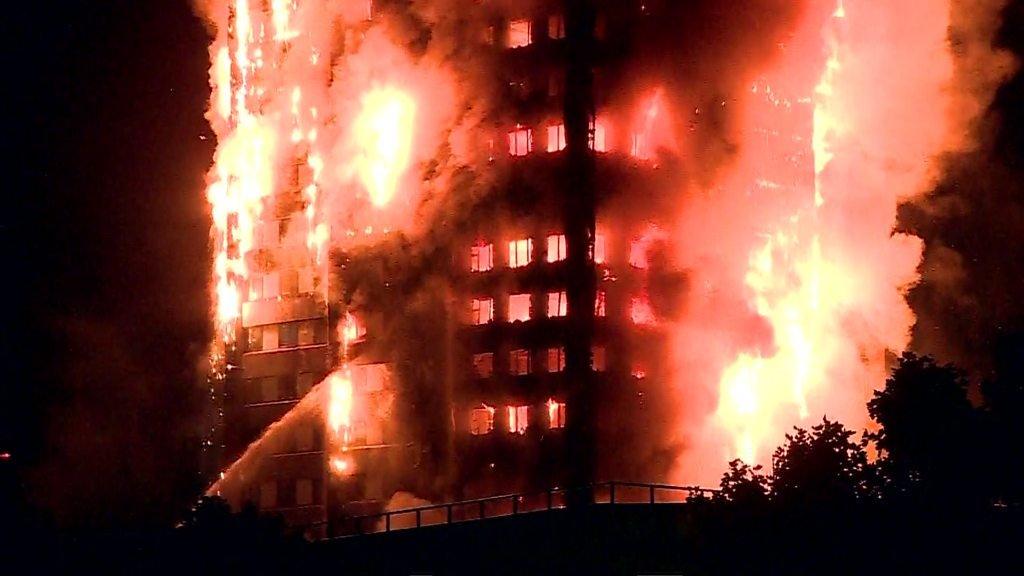How the tragedy unfolded at Grenfell Tower
- Published

Seventy-two people died after a huge fire engulfed Grenfell Tower, a west London residential tower block, in the early hours of Wednesday, 14 June 2017.

What happened?
More than 200 firefighters and 40 fire engines responded to the fire at the 24-storey block in North Kensington, after it was reported at 00:54 BST (23:54 GMT).
It took until 01:14 BST the following day to get it under control, with the fire destroying 151 homes, both in the tower and surrounding areas.
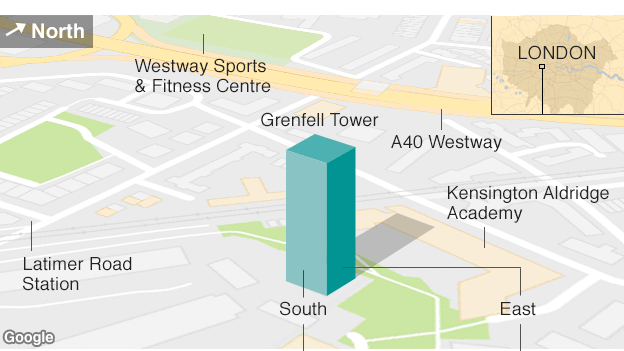


How many victims were there?
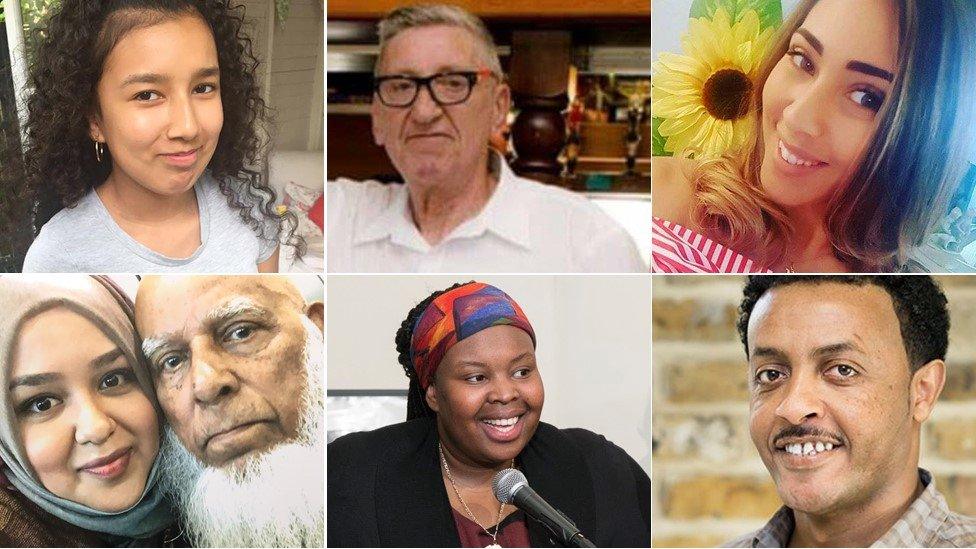
Seventy-two people died in the fire, including baby Logan Gomes, who was stillborn in hospital on 14 June after his parents escaped the tower block, and Maria Del Pilar Burton, 74, who died in January 2018.
She had been in hospital since being rescued from the 19th floor.
The Metropolitan Police say 350 people should have been in the tower block on the night of the blaze. Fourteen residents were not in the building at the time.
Footage shows the extent of damage
Sixty-five people were rescued by the fire brigade. But a BBC investigation found a series of failings hampered the efforts of firefighters to tackle the fire and rescue the building's residents.
London Mayor Sadiq Khan said fire crews only managed to reach the 12th floor at the height of the fire.
There were claims from within the local community - and by celebrities such as Lily Allen and rapper Akala - that the true death toll was being suppressed by the media.

What caused the fire?
The fire started in a Hotpoint fridge freezer on the fourth floor. Police say it was not started deliberately.
Footage has shown the fire spreading up one side of the building externally, before engulfing the entire block.
A subsequent investigation said the Hotpoint FF175B model posed a "low risk" and did not need modifications.
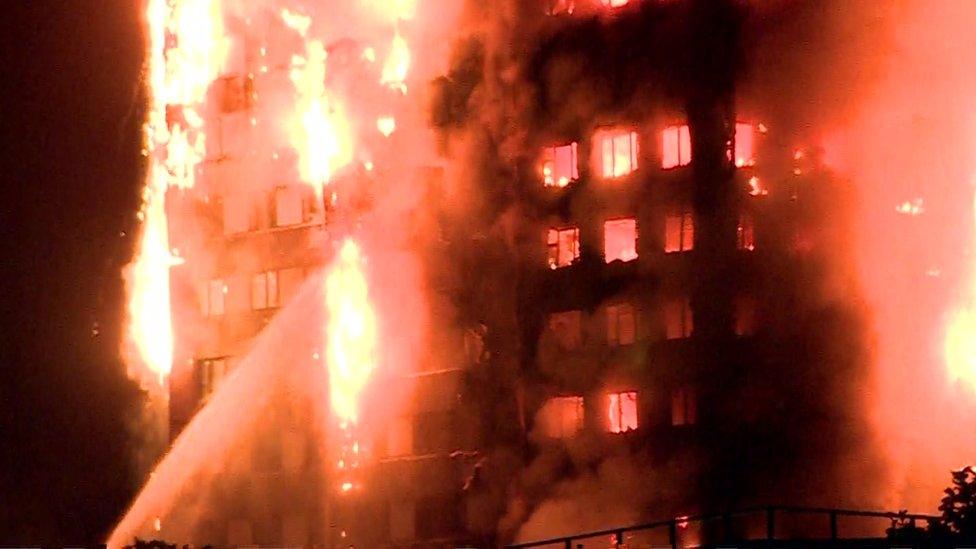
No product recall was required, the investigation concluded, and consumers have been advised they can carry on using the model as normal.
The helpline for owners of the Hotpoint model is 0800 316 3826 or visit the Hotpoint website., external

What about the cladding?

Flammable cladding - installed on Grenfell Tower in a recent renovation - is thought to have contributed to the rapid spread of the fire.
Both the cladding and insulation on the outside of the building failed all preliminary tests by the police. The insulation samples burned more quickly than the cladding tiles.
Documents obtained by the BBC suggest the cladding fitted during its refurbishment was changed to a cheaper version.
They show the zinc cladding originally proposed was replaced with an aluminium type, which was less fire resistant, saving nearly £300,000.
Cladding can create cavities which in some cases can cause a chimney effect, drawing flames up the cavity if there are no fire barriers.
The Department for Communities and Local Government said composite aluminium panels with a polyethylene core should not be used as cladding on buildings over 18m high.
Engineering and manufacturing company Arconic later said one of its products, Reynobond PE (polyethylene) - an aluminium composite material - was "used as one component in the overall cladding system" of Grenfell Tower.

What do we know about Grenfell Tower?
Grenfell Tower was built in 1974 by Kensington and Chelsea London Borough Council.
An £8.6m refurbishment - which was part of a wider transformation of the estate - was completed by Rydon Construction in May 2016. Work included new exterior cladding, replacement windows and a communal heating system.
There was also extensive remodelling of the bottom four floors, creating seven additional homes, and improvements to communal facilities.
Plans for the development, external show how the building was modified, external and the single stairway.
Rydon said it was "shocked to hear of the devastating fire", adding that the work met "all required building regulations".
The tower was managed by the Kensington and Chelsea Tenant Management Organisation (KCTMO) on behalf of the council.


Had there been safety concerns about the tower?
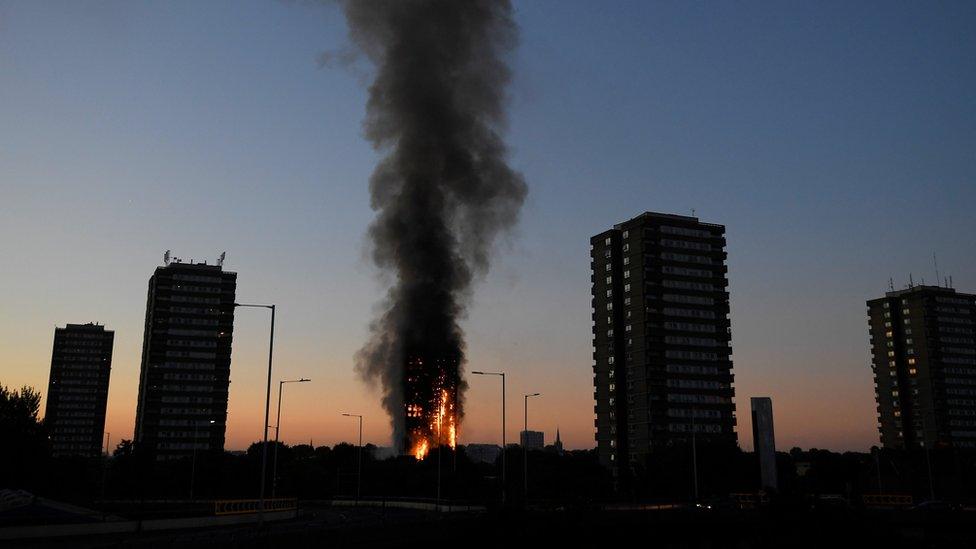
The Grenfell Action Group, external had claimed, before and during the refurbishment, that the block constituted a fire risk and residents had warned that access to the site for emergency vehicles was "severely restricted".
In February 2013 residents warned fire safety equipment, including fire extinguishers, had not been tested for 12 months.
KCTMO said it was aware that concerns had been raised historically by residents and they would form part of its investigations.
The tower block was given a medium fire risk rating - defined as a normal fire risk - in 2016 following completion of the refurbishment by the London Fire Brigade and Kensington and Chelsea Council.
The council insisted the block had been regularly inspected.
The fire safety advice for Grenfell Tower residents was to "stay put" - unless the fire was affecting their own flat.
This is because tower block flats are built as a fire-resistant box, completely surrounded by fire-resisting construction from the rest of the building.
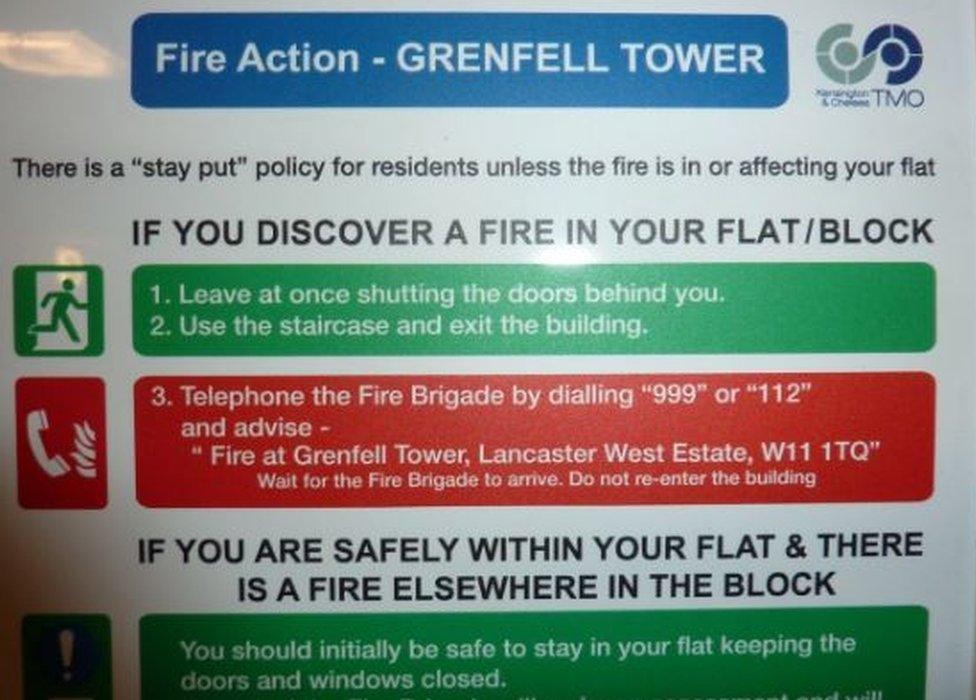
What did witnesses say?
London fire: Families threw children out of Grenfell Tower to safety
Witnesses said they saw people trapped inside the burning building screaming for help and shouting for their children to be saved.
Some said they saw lights - thought to be mobile phones or torches - flashing at the top of the block of flats, and trapped residents coming to their windows, some holding children.
Witness Jody Martin said: "I watched one person falling out, I watched another woman holding her baby out the window... hearing screams."
Tiago Etienne, 17, saw small children being thrown out of the building from as high as the 15th floor. But doubt has been raised as to whether any children were thrown from the building.
Christos Fairbairn, 41, a resident on the 15th floor, told the BBC how he managed to brave the toxic smoke and make his way out of the burning building.

What happened in the immediate aftermath of the fire?

Dozens of people stormed Kensington and Chelsea Town Hall demanding more support for the fire's survivors.
Prime Minister Theresa May was criticised for her reaction to the fire, and she told the House of Commons that the official response had "not been good enough".
Kensington and Chelsea council's chief executive, Nicholas Holgate and council leader Nick Paget-Brown resigned amid criticism over the handling of the tragedy.
The chief executive of Kensington and Chelsea Tenant Management Organisation, the council's arms-length body which manages the tower, stepped down to "concentrate on assisting with the investigation and inquiry", before quitting six months later.

What about the public inquiry?
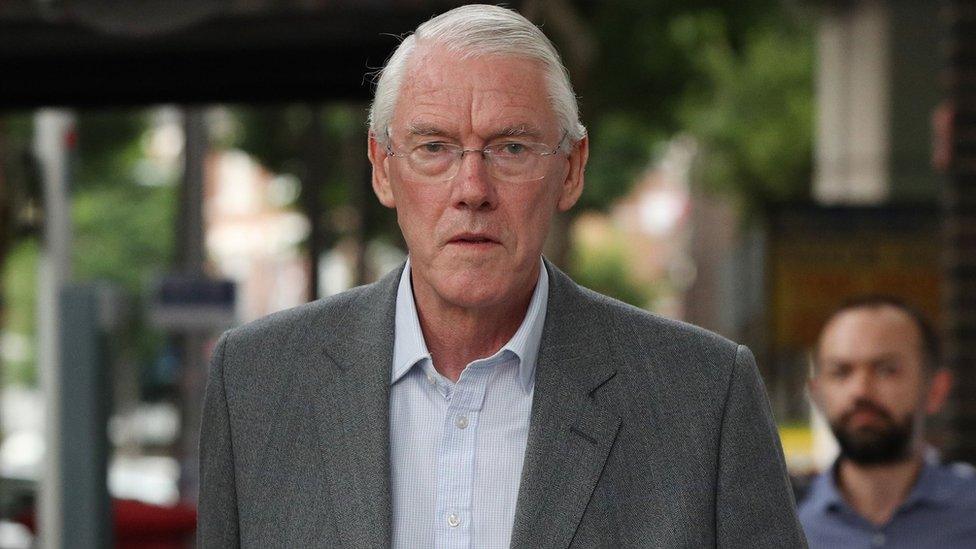
Sir Martin Moore-Bick is leading the Grenfell Tower Inquiry
A public inquiry, external, led by retired judge Sir Martin Moore-Bick, is taking place. The formal opening of the Inquiry took place on 14 September 2017 and the first procedural hearing on 10 and 11 December 2017.
Commemoration hearings - where families can pay tribute to their loved ones who died - begin on 21 May 2018., external. Other hearings will take place throughout the summer and into September.
The inquiry is looking at the adequacy of regulations, the tower's refurbishment, and the response of authorities in the aftermath.
In May, the government agreed that two experts will sit with Sir Martin, following pressure from campaigners.
The new panel will join the second phase of the inquiry, which is not expected to begin until after December.

What about other tower blocks?
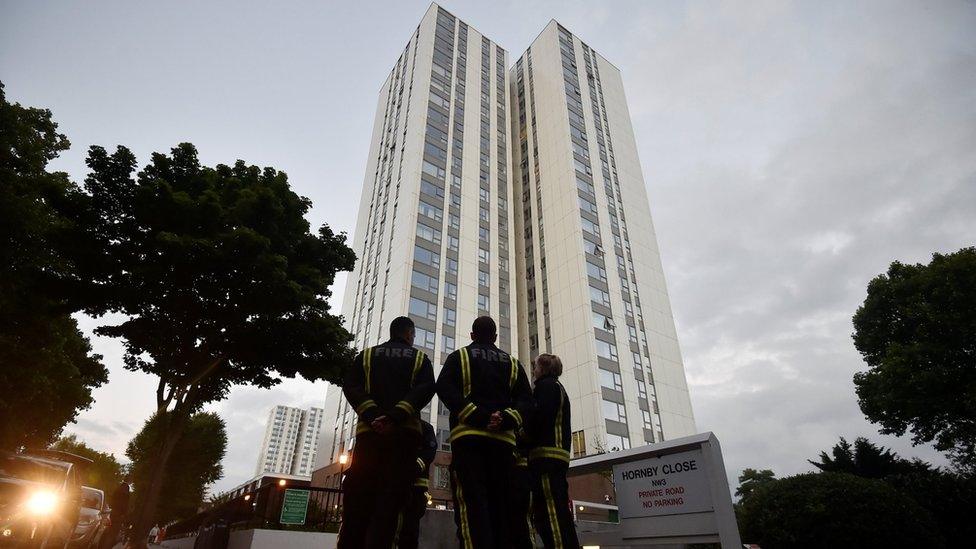
People were evacuated from tower blocks in north London in the aftermath of the fire
A survey in the aftermath of the fire identified 228 other buildings where cladding failed safety tests.
Residents were evacuated from four blocks on the Chalcots Estate in Swiss Cottage, north London, with five buildings failing cladding tests.
In May 2018, the government announced a £400m operation to remove dangerous cladding from tower blocks owned by councils and housing associations.
A consultation on banning flammable cladding on high-rise buildings was announced in May - on the same day an independent review stopped short of recommending such a move.
Instead, the review recommended a "radical rethink" of building safety regulations - including tougher penalties for those who breach the rules.


- Published14 June 2017
